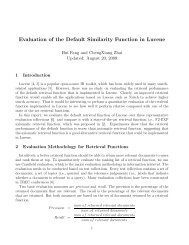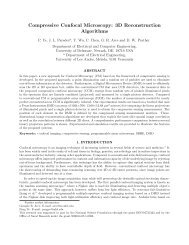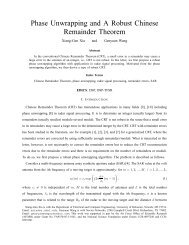HW9Sol.pdf
HW9Sol.pdf
HW9Sol.pdf
You also want an ePaper? Increase the reach of your titles
YUMPU automatically turns print PDFs into web optimized ePapers that Google loves.
70<br />
Chapter 17<br />
17.1 We wish to use a photodiode as a detector for a signal of 9000 Å wavelength.<br />
Which would be the best choice of material for the photodiode, a semiconductor of<br />
bandgap = 0.5 eV, bandgap = 2 eV, or bandgap = 1 eV? Why? (Assume all three<br />
are direct gap and are equivalent in impurity content, etc.)<br />
Solution.<br />
λ1 = 1.24<br />
= 2.48 µm<br />
0.5<br />
λ2 = 1.24<br />
= 6200 Å<br />
2<br />
λ3 = 1.24<br />
= 1.24 µm<br />
1<br />
λ2 cutoff at too short a wavelength<br />
λ1 cutoff at to long a wavelength<br />
(increases bandwidth for noise – reduces S/N).<br />
17.2 To improve the signal-to-noise ratio of the diode in Problem 17.1, we wish to<br />
use a semiconductor low-pass filte which has the following absorption properties at<br />
room temperature:<br />
for 9000 Å radiation α = 0.2cm−1 for 7000 Å radiation α = 103 cm−1 .<br />
How thick must the filte be to attenuate 7000 Å background noise by a factor of<br />
104 ?<br />
By what factor is the signal (at 9000 Å) attenuated by a filte of this thickness?<br />
Neglect reflectio at the surfaces.<br />
Solution.<br />
I<br />
e −αz<br />
I0<br />
1<br />
10 4 = e−103 z<br />
I<br />
I0<br />
z = 9.21 × 10 −3 cm<br />
= e −2×10−1 ×9.21×10−3 = 0.999<br />
17.3 If the minimum useful photocurrent of the diode in Problem 17.1 is 1 µA<br />
(peak pulse value), what is the minimum signal light intensity (peak pulse value)<br />
which must fall on the detector? Assume an internal yield or quantum efficien y<br />
ηq = 0.8 and sensitive area = 10 mm 2 .
Solution.<br />
10−6 coul/sec × 1.25 photons/carrier<br />
1.6 × 10−19 = 7.8 × 10<br />
coul/carrier<br />
12 photons/sec .<br />
7.8 × 1012 photons/sec × 1.38 eV/photon × 1.60 × 10−19 joules/eV<br />
10−1 cm2 = 1.72 × 10 −5 watts/cm 2<br />
17.4 Below is a list of semiconductor materials and their bandgaps.<br />
Eg[eV]<br />
Si 1.1<br />
GaAs 1.4<br />
GaSb 0.81<br />
GaP 2.3<br />
InAs 0.36<br />
a) Based solely on bandgap energy, which of these materials could possibly be<br />
used to make a detector for the light from a GaAs laser?<br />
b) Which of the following ternary compounds could possibly be used to make<br />
a detector for the light from a GaAs laser?<br />
GaAs(1−x)Sbx GaAs(1−x)Px Ga(1−x)InxAs<br />
c) If a reverse biased Si photodiode with a quantum efficien y of η = 80% and<br />
an area of 1 cm 2 is uniformly illuminated with the light from a GaAs laser to an<br />
intensity of 10 mW/cm 2 what is the photocurrent which f ows?<br />
Solution.<br />
a) For eff cient detection you need Eg < Ephoton and for a GaAs laser Ephot � 1.4eV<br />
∴Si, GaSb, InAs will work<br />
GaP will not work<br />
b) GaAs1−xSbx and Ga1−xInxAs would work because GaSb and InAs have bandgaps<br />
less than that of GaAs. GaAs1−xPx would not work because the bandgap of GaP<br />
exceeds that of GaAs.<br />
c) 10 × 10 −3 W/cm 2 × 1cm 2 = 10 −2 W of optical power, each photon has<br />
1.24/0.9 × 1.6 × 10 −19 = 2.20 × 10 −19 joules of optical power ∴ the number of<br />
photons striking the detector is<br />
10−2 2.2 × 1019 = 4.55 × 1016 photons/sec<br />
at 80% quantum efficien y the current is<br />
4.55 × 10 16 × 0.8 × 1.6 × 10 −19 = 5.82 mA<br />
71
72<br />
17.5 a) Determine the maximum value of the energy gap which a semiconductor,<br />
used as a photodetector, can have if it is to be sensitive to light of wavelength<br />
λ0 = 0.600 µm.<br />
b) A photodetector whose area is 5 × 10 −6 m 2 is irradiated with light whose<br />
wavelength is λ0 = 0.600 µm and intensity is 20 W/m 2 . Assuming each photon<br />
generates one electron-hole pair, calculated the number of pairs generated per second.<br />
c) By what factor does the answer to (b) change if the intensity is reduced by<br />
a factor of 1/2?<br />
d) By what factor does the answer to (b) change if the wavelength is reduced by<br />
a factor of 1/2?<br />
Solution.<br />
a) E = hν = hc<br />
λ<br />
= 6.6 × 10−34 × 3 × 108 6000 × 10−10 = 3.3 × 10 −19 joule<br />
= 3.3 × 10−19<br />
= 2.06 eV<br />
1.6 × 10−19 b) 20 Watts<br />
m 2 × 5 × 10−6 m 2 = 10 −4 watts<br />
pairs generated<br />
sec<br />
=<br />
10 −4 joule/sec<br />
3.3 × 10 −19 joules/pair = 3 × 1014 pairs/sec<br />
c) Intensity = 20 Watts/cm2 × 1<br />
2 = 10 Watts/cm2<br />
pairs/sec reduced by factor of 1<br />
2<br />
6000 × 10−10<br />
d) If λ = = 3000 × 10<br />
2<br />
−10<br />
Energy per photon = E = hc<br />
λ = 6.6 × 10−19 joule<br />
10 −4 joules/sec<br />
6.6 × 10 −19 joule<br />
also a factor of 1<br />
2<br />
17.6 We wish to design a waveguide photodiode in GaAs, with the geometry as<br />
shown in Fig. 17.5, for operation at λ0 = 0.900 µm wavelength.<br />
a) If the photodiode has a waveguide thickness and depletion width W = 3 µm<br />
at an applied reverse bias voltage of 40.5 V, what is the magnitude of the change in<br />
effective bandgap due to the electric f eld? (Assume m ∗ = 0.067m0).<br />
b) What length L is required to produce a quantum efficien y of 0.99? (Assume<br />
that scattering loss and free carrier absorption are negligible).
Solution.<br />
a) The fiel in the depletion layer is<br />
E = 40.5<br />
3 × 10−4 V/cm = 1.35 × 105 V/cm or 1.35 × 10 7 From (9.19)<br />
V/m<br />
∆E = 3<br />
2 (m∗ ) −1/3 (qEh) 2/3<br />
= 3<br />
2 (9.1 × 10−31 × 0.067 kg) −1/3 [(1.6 × 10 −19 × 1.35 × 10 7 V/m)<br />
× (1.05 × 10 −34 Js)] 2/3<br />
= 3<br />
2 · (3.72 × 10−31 )m∗ kg4/3 /s2 (3.94 × 10−11 ) kg1/3 = 1.42 × 10 −20 J<br />
= 1.42 × 10−20<br />
eV<br />
1.6 × 10−19 = 0.089 eV<br />
b) From Fig.9.2, α = 10 4 cm −1<br />
ηq = 1 − e −αL<br />
0.99 = 1 − e −104 ·L<br />
− 10 4 · L = ln 0.01 L = 4.6. × 10 −4 cm<br />
L = 4.6. µm<br />
73
80<br />
Chapter 18<br />
18.1 Explain the difference between a multiple quantum well structure and a superlattice.<br />
Solution. See text Sect. 16.1.<br />
18.2 For a deep quantum well of GaAs with a thickness Lz = 70 Å, L x = L y =<br />
100 µm, calculate the magnitude of the steps in the conduction band cumulative<br />
density of states function and the energies at which they occur relative to the bottom<br />
of the well for the n = 1, 2 and 3 levels. (Assume that the well has infinitel high<br />
sidewalls.)<br />
Solution.<br />
∆ϱ(E) me 4meπ<br />
=<br />
πh2 h2 = 4(0.08)(9.1 × 10−31 )π<br />
(6.625 × 10−34 ) 2<br />
= 2.08 × 10 36<br />
K y = Kx = nπ<br />
10−4 n = 1, 2, 3<br />
En = h2<br />
� �2 nπ<br />
+<br />
2me Lz<br />
h2<br />
(K<br />
2me<br />
2 x + K 2 y ) n = 1, 2, 3<br />
En = (1.054 × 10−34 ) 2<br />
2(0.08)9.1 × 10−31 �<br />
nπ<br />
7 × 10−9 �2 + (1.504 × 10−34 ) 2<br />
2(0.08)9.1 × 10−31 �� nπ<br />
10−4 �2 �<br />
nπ<br />
+<br />
10−4 � �<br />
2<br />
En = 7.36 × 10 −38<br />
�<br />
nπ<br />
7 × 10−9 �2 + 7.63 × 10 −38 �<br />
nπ<br />
(2)<br />
10−4 �2 for n = 1<br />
E1 = 7.63 × 10 −38 (2.01 × 10 17 ) + 7.63 × 10 −38 (2)(9.87 × 10 8 )<br />
= 1.53 × 10 −20 + 1.51 × 10 −28 = 1.53 × 10 −20 Joule = 0.0956 eV<br />
E2 = 1.53 × 10 −20 (4) + 1.51 × 10 −28 (9) = 6.12 × 10 −20 =0.383 eV<br />
E3 = 1.53 × 10 −20 (9) + 1.51 × 10 −28 (9) = 1.38 × 10 −19 =0.860 eV<br />
18.3 If the quantum well of Problem 18.2 were incorporated into a diode laser,<br />
what would be the emission wavelength for electron transitions between the n = 1<br />
level in the conduction band and the n = 1 level in the valence band? (Assume 300 K<br />
operation.)<br />
Solution. From problem 16.2 the energy of a conduction band electron in n = 1<br />
level<br />
E1 = 0.0956 eV
For a hole in the valence band n = 1 level, the equation is the same except that<br />
me = 0.08 m0 is replaced by mh = 0.5 m0, thus for the hole<br />
0.0956 eV<br />
E1 = 0.0956 0.08<br />
0.5<br />
0.0153 eV<br />
The photon energy is<br />
= 0.0153 eV<br />
Eg = 1.38 eV<br />
Eph = 0.0956 + 1.38 + 0.0152 = 1.49 eV<br />
The emission wavelength is<br />
λ = 1.24<br />
Eph<br />
= 1.24<br />
= 0.832 µm<br />
1.49<br />
18.4 a) Explain how a single p-i-n MQW diode can function as a self-electro-opticeffect<br />
device (SEED).<br />
b) Why are SEEDs envisioned as being possible digital logic elements in<br />
Solution. See text Sect. 16.5.<br />
18.5 A single-quantum well of GaAs with a thickness of 60 Å is incorporated into<br />
a GaAlAs heterojunction laser. The laser has a stripe geometry, being 200 µm long<br />
and 10 µm wide.<br />
a.) What is the emission wavelength if the energy bandgap is Eg = 1.52 eV in<br />
the emitting region and electron transitions occur between the n = 1 level in the<br />
conduction band and the n = 1 level in the valence band?<br />
b). If the gain coefficien of the laser in part (a) is g = 80 cm−1 , what would be<br />
the gain coefficien of a multiple quantum well laser with 20 identical wells?<br />
Solution.<br />
a.) En = �2<br />
� �2 nπ<br />
+<br />
2me Lz<br />
�2<br />
(k<br />
2me<br />
2 x + k2y )<br />
where kx = nπ/L x and ky = nπ/L y<br />
taking n = 1 and realizing that k2 x and k2y are negligible since L x, L y ≫ Lz<br />
E1 = �2<br />
� �2 π<br />
(1.055 × 10<br />
=<br />
2me Lz<br />
−34 ) 2π 2<br />
2 × 0.08 × 9.1 × 10−31 (6 × 10−9 = 2.123 × 10−2<br />
) 2<br />
2.123 × 10−20<br />
E1 = = 0.13 eV<br />
1.60 × 10−19 E1<br />
Ec<br />
Ev<br />
E1<br />
81
82<br />
for holes m ∗ changes from 0.08 me to 0.5 me then<br />
E1 = 0.13 × 0.08<br />
0.5<br />
The photon energy is<br />
= 0.02 eV<br />
Ephot = �w = Eg + E1C + E1V = 1.52 + 0.13 + 0.02 = 1.67 eV<br />
The emission wavelength is λ0 = 1.24/1.67 = 0.743 µm<br />
b). 20 × 80 = 1600 cm −1
Chapter 19<br />
19.1 If a silicon rod of 1 mm diameter is exposed to a tensional force by supporting<br />
a 3 g weight,<br />
a. What axial stress does the rod experience?<br />
b. What is the axial strain?<br />
c. What is the longitudinal strain?<br />
Solution.<br />
a. G = F/π(θ/2) 2<br />
(1lb/in 2 = 703.1kg/m 2 )<br />
= 3 × 10−3 kg<br />
π(10−3 /2) m2 = 3819 kg/m2 = 5.43 lb/in 2<br />
b. G = εE<br />
εE = G<br />
E =<br />
=−1.97 × 10 −7<br />
↑ tension<br />
c. ν =−εl/εa<br />
5.43 lb/in 2<br />
190 GPa × 1.45 × 10 5� lb<br />
in 2 /GPa �<br />
εl =−ν × εa = (−0.28 ×−1.97 × 10 −7 )<br />
= 5.5 × 10 −8<br />
19.2 A square membrane of silicon, 7 mm on a side and 150 µm thick, is exposed<br />
uniformly over its surface to a pressure of 1 × 10 4 kg/m 2 .<br />
a. What is the deflectio at the center point of the membrane?<br />
b. What is the maximum longitudinal stress?<br />
c. What is the maximum transverse stress?<br />
d. What is the resonant frequency of the membrane?<br />
Solution.<br />
83
84<br />
a. D = EA 3 /[12(1 − ν 2 )]<br />
= 190 GPa × (150 × 10−6 ) 3<br />
[12(1 − 0.282 )]<br />
= 6.96 × 10 −10 GPa m 2<br />
wmax = 0.001265 Pa 4 /D<br />
=<br />
= 6.41 × 10−10<br />
(1 − 0.28 2 )<br />
0.001265 kg/m 2 × (7 × 10 −3 ) 4 m 4<br />
6.96 × 10 −10 GPa m 2 × 1.02 × 10 8 (kg/m 2 )/GPa<br />
= 6.41 × 10−10<br />
.9216<br />
= 4.28 × 10 −11 P meters = 4.28 × 10 −5 P µm with P in kg/m 2<br />
take P = 10 4 kg/m 2<br />
wmax = 4.28 × 10 −1 µm = 0.428 µm<br />
b. Gl = 0.3081 P(a/t) 2<br />
= 0.3081 × 10 4 (7/0.15) 2 = 6.71 × 10 6 kg/m 2<br />
c. Gt = νGl = 0.28 × 6.71 × 10 6 = 1.88 × 10 6 kg/m 2<br />
d. F0 = (1.65 t/a 2 )[E/e(1 − ν 2 )] 1/2<br />
× 1.654 × 150 × 10−6<br />
(7 × 10 −3 ) 2<br />
� 190 × 1.02 × 10 8<br />
2.3 × 10 3 (1 − 0.28)<br />
= 5.063 × 9.14 × 10 6 = 4.63 × 10 7 = 46.3MHz<br />
19.3 A silicon cantilever beam, 1.5 mm long, 500 µm wide and 250 µm thick, is<br />
loaded with a uniformly distributed force per unit width of 100 kg/m 2 .<br />
a. What is the deflectio at the point 0.5 mm from the free end?<br />
b. What is the maximum stress?<br />
c. What is the frequency of the fundamental vibrational mode?<br />
Solution.<br />
�1/2
a. W(P, x) = (Px 2 /24 EI)(6L 2 − 4Lx + x 2 )<br />
I = at 3 /12 = 500 × 10−6 (250 × 10−6 ) 3<br />
= 6.51 × 10<br />
12<br />
−16<br />
W(P, 1 × 10 −3 P × 1 × 10<br />
) =<br />
−6<br />
24 × 190 × 1.02 × 10 +8 × 6.51 × 10−16 × � 6(1.5 × 10 −3 ) 2 − 42x − x 2 )<br />
= P × 3.30 × 10 −3 (1.35 × 10 −5 − 4 × 1.5 × 10 −3<br />
× 1 × 10 −3 × 1 × 10 −6 )<br />
= P × 3.30 × 10 −3 (6.5 × 10 −6 )<br />
= P × 2.1 × 10 −8<br />
let P = 100 kg/m<br />
w = 2.1 × 10 −6 m = 2.1 µm<br />
b. Gmax = PL2t 4I = 100 × (1.5 × 10−3 ) 2 (250 × 10−6 )<br />
4 × 6.51 × 10−16 = 2.16 × 10 7 kg/m 2<br />
c. F0 = 0.161(t/L 2 )(E/C) 1/2<br />
� −6 250 × 10<br />
= 0.161<br />
(1.5 × 10−3 ) 2<br />
�� 8<br />
190 × 1.02 × 10<br />
2.3 × 103 = 3.23 × 10 5 = 323 kHz<br />
�1/2<br />
85











